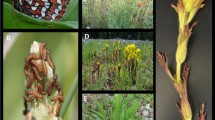Summary
Prediapause larvae of the checkerspot butterfly Euphydryas chalcedona were raised from hatch until entrance into diapause on artificial diets. The proportions of protein and host plant leaf resin differed among the diets. Larval size growth rates and mortality were monitored and overall rates and efficiencies of food use were computed.
Larval survivorship, growth rate and size of larvae at idapause were significantly enhanced by increasing dietary protein content, particularly over the range found in leaves of the host plant. In contrast, an increasing dietary content of Diplacus aurantiacus leaf resin significantly depressed larval surviviorship, growth rates and size of larvae at diapause. A simple dosedependent interaction was observed between the effects of dietary leaf resin and protein on larval success. Dietary content of leaf resin and protein significantly influenced some measures of food utilization efficiency (ECI and ECD), but not others (AD and NUE).
The negative interaction between the effects of dietary leaf resin and protein content suggests the leaf resin phenolic compounds reduce the availability of protein to the larvae. The results for efficiency indices of larval food use are potentially in conflict with this interpretation.
The influence of host plant leaf resin and protein on larval success, coupled with the relation between photosynthesis and leaf nitrogen content, are consistent with the hypothesis that productivity can be enhanced by herbivore deterrence resulting from leaf resin production.
Similar content being viewed by others
References
Beck SD, Reese JC (1976) Insect-plant interactions: nutrition and metabolism. Rec Adv Phytochem 10:41–92
Berenbaum M (1980) Adaptive significance of midgut pH in larval Lepidoptera. Amer Naturalist 115:138–146
Bjorkman O (1973) Comparative studies on photosynthesis in higher plants. In: AC Giese (ed) Photophysiology Vol III. Academic Press New York, pp 1–63
Bowers MD (1981) Unpalatability as a defense strategy of western checkerspot butterflies (Euphydryas Scudder, Nymphalidae). Evolution 35:367–375
Brown IL, Ehrlich PR (1980) Population biology of the checkerspot butterfly, Euphydryas chalcedona. I. structure of the Jasper Ridge Colony. Oecologia (Berl) 47:239–251
David WAL, Gardiner BOC (1966) Mustard oil glucosides as feeding stimulants for Pieris brassicae larvae in a semi-synthetic diet. Ent Exp & Appl 9:247–255
Ehrlich PR, Raven PH (1965) Butterflies and plant: a study in coevolution. Evolution 18:586–608
Ehrlich PR, White RR, Singer MC, McKechnie SW, Gilbert LE (1975) Checkerspot butterflies: a historical perspecitive. Science 188:221–228
Feeny PP (1969) Inhibitory effect of oak leaf tannins on the hydrolysis of proteins by trypsin. Phytochemistry 8:2119–2126
Feeny PP (1970) Seasonal changes in oak leaf tannins and nutrients as a cause of spring feeding by winter moth caterpillars. Ecology 51:565–581
Feeny PP (1976) Plant apparency and chemical defense. Rec Adv Phyüchem 10:1–40
Fox LR, Macauley BJ (1977) Insect grazing on Eucalyptus in response to variation in leaf tannins and nitrogen. Oecologia (Berl) 29:145–162
Fraenkel G (1959) The raison d'etre of secondary plant substances. Science 129:146–170
Fraenkel G (1969) Evaluation of our thoughts on secondary plant substances. Sciences 129:146–170
Goldstein JL, Swain T (1965) The inhibition of enzymes by tannins. Phytochemistry 4:185–192
Gulmon SL, Chu CC (1981) The effects of light and nitrogen on photosynthesis, leaf characteristics and dry matter allocation in the chaparral shrub, Diplacus aurantiacus. Oecologia (Berl) 49:207–212
Isaac RA, Johnson WC (1976) Determination of total nitrogen in plant tissue, using a block digestor. J Association of Official Analytical Chemists 59:98–100
Lincoln DE (1980) Leaf resin flavonoids of Diplacus auranntiacus. Biochemical Systematics and Ecology 8:397–400
Mattson WJ (1980) Herbivory in relation to plant nitrogen content. Ann Rev Ecol Syst 11:119–161
Mooney HA, Ferrar PJ, Slayter RO (1978) Photosynthetic capacity and carbon allocation patterns in diverse growth forms of Eucalyptus. Oecologia (Berl) 36 103–111
Mooney HA, Ehrlich PR, Lincoln DE, Williams KS (1980) Environmental controls on the seasonality of a drought-deciduous shrub, Diplacus aurantiacus and its predator, the checkerspot butterfly, Euphydryas chalcedona. Oecologia (Berl) 45:143–146
Mooney HA, Williams KS, Lincoln DE, Ehrlich PR (1981) Temporal and spatial variability in the interaction between the checkerspot butterfly, Euphydryas chalcedona and its principal food source, the californian shrub, Diplacus aurantiacus. Oecologia (Berl) 50: 195–198
Rhoades DF (1977) Integrated antiherbivore, antidesiccant and ultraviolet screening properties of creosotebush resin. Biochemical Systematics and Ecology 5:281–290
Rhoades DF, Cates RG (1976) Toward a general theory of plant antiherbivore chemistry. Rec Adv Phytochem 10:168–213
Schoonhoven LM (1973) Plant recognition by lepidopterous larvae. Symp R Entomol Soc London 6:87–99
Scriber JM, Feeny P (1979) Growth of herbivorous caterpillars in relation to feeding specialization and to growth form of their food plants. Ecology 60:829–850
Scriber JM, Slansky F (1981) The nutritional ecology of immature insects. Ann Rev Entomol 26:183–211
Singer MC, Ehrlich PR (1979) Population dynamics of the checkerspot butterfly Euphydryas editha. Fortschr Zool 25:53–60
Slansky F (1977) Stabilization of the rate of nitrogen accumulation by larvae of the cabbage butterfly on wild and cultivated food plants. Ecol Monogr 47:209–228
Soo Hoo DF, Fraekel G (1966) The consumption, digestion, and utilization of food plants by a polyphagous insect, Prodenia eridania (Cramer). J Insect Physiol 12:711–730
Van Emden HF (1966) Studies on the relations of insects and host plant III. a comparison of the reproduction of Breviocoryne brassicae and Myzus persicae (Hemiptera: Aphidae) on brussel sprout plants supplied with different rates of nitrogen and potassium. Ent Exp & Appl 9:444–460
Waldbauer GP (1968) The consumption and utilization of food by insects. Adv Insect Physiol 5: 229–288
Whittaker RH, Feeny PP (1971) Allelochemics: chemical interactions between species. Science 171:757–770
Author information
Authors and Affiliations
Rights and permissions
About this article
Cite this article
Lincoln, D.E., Newton, T.S., Ehrlich, P.R. et al. Coevolution of the checkerspot butterfly Euphydryas chalcedona and its larval food plant Diplacus aurantiacus: larval response to protein and leaf resin. Oecologia 52, 216–223 (1982). https://doi.org/10.1007/BF00363840
Received:
Issue Date:
DOI: https://doi.org/10.1007/BF00363840




